Thoughts on an imminent death
by Brian Byrne
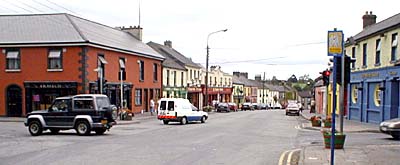
Kilcullen as we know it is on the way to its grave.
OK, so nobody, or no thing, lives forever. But we should be aware of impending death, at least. Not to stop it - because this is not possible in most things in life and especially its end - but to be prepared. Being prepared takes the sting out of death.
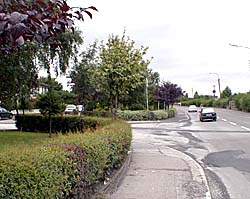 For those who don’t remember, my writing career began with a eulogy for the Big Tree. It was taken down overnight to make way for the development of a county council housing estate (right) - unnecessarily, really, because the Big Tree could have made a nice natural statement about the longevity of a people in a small village. I wrote a back page opinion piece in Kilcullen's community magazine, The Bridge, about ‘The Big Tree is Dead’. Somebody might still have a copy. Not that it matters, because the tree was gone by the time I wrote it.
For those who don’t remember, my writing career began with a eulogy for the Big Tree. It was taken down overnight to make way for the development of a county council housing estate (right) - unnecessarily, really, because the Big Tree could have made a nice natural statement about the longevity of a people in a small village. I wrote a back page opinion piece in Kilcullen's community magazine, The Bridge, about ‘The Big Tree is Dead’. Somebody might still have a copy. Not that it matters, because the tree was gone by the time I wrote it.
So now, having learned my lesson at least in some small part, I’m writing about the death of Kilcullen a little way in advance of the town being actually ready for the undertaker. If for no other good reason than to make sure that we organise a decent wake.
It’s already happening. Land has been aquired, rezoned, and is waiting for the sewerage works to be completed so that many houses can be put on them. Don’t get me wrong ... I’m not knocking the people involved. Some are people I grew up with and respect and are probably dead right to be doing what they are doing. I myself applaud them for their good sense and their business acumen. Without them Kilcullen would not have been what it has been, and would not be what it is today. And we must hope that they will be a major part in ensuring what will be a prosperous and strong community in the future. As may also be the people from outside buying in to the action.
But let us now remember while we can, the Kilcullen that we grew up in. Parts of which are already no longer, for decent enough reasons in the main.
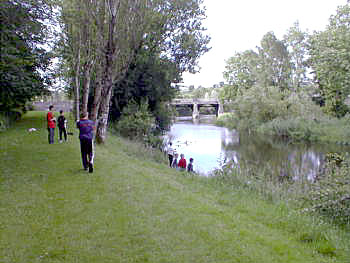 Recently I took a Sunday afternoon’s walk down the Valley, where when I was growing up was a wilderness with steep and dangerous trails through it that were part of the adventureland we all as children played in. Now it is the Valley Park (left), bought adventurously for the community and later developed to what it is by adventurous means which were often later copied by other communities throughout Ireland.
Recently I took a Sunday afternoon’s walk down the Valley, where when I was growing up was a wilderness with steep and dangerous trails through it that were part of the adventureland we all as children played in. Now it is the Valley Park (left), bought adventurously for the community and later developed to what it is by adventurous means which were often later copied by other communities throughout Ireland.
But there’s no adventure going through it now. And probably less children use it than did when it was partly forbidden and very hidden and known best by those of us who set lines at night to catch eels, illegally, we believed and enjoying the belief.
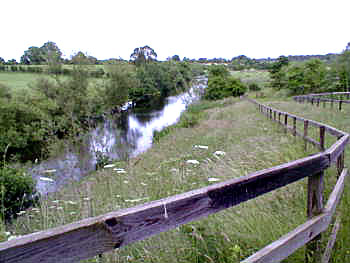 Further on was the late Ken Urquhart’s land, a short cut to the graveyard and, more important, the place where many of us learned to swim and later lie in the sun before we were told by experts that sun was bad for us. And that river water was polluted and bad for us. And that the best place to learn to handle oneself in the water was a municipal swimming pool (as if that can prepare you for the sudden rush of an unannounced Phoulaphuca flood). Ken himself acknowledged this importance by providing and maintaining a diving board at the deeper part of the Liffey on his land. Ken was an obnoxious man in many respects, but he had some good thoughts.
Further on was the late Ken Urquhart’s land, a short cut to the graveyard and, more important, the place where many of us learned to swim and later lie in the sun before we were told by experts that sun was bad for us. And that river water was polluted and bad for us. And that the best place to learn to handle oneself in the water was a municipal swimming pool (as if that can prepare you for the sudden rush of an unannounced Phoulaphuca flood). Ken himself acknowledged this importance by providing and maintaining a diving board at the deeper part of the Liffey on his land. Ken was an obnoxious man in many respects, but he had some good thoughts.
Now there’s a fence, and no swimmers encouraged. No swimmers, period.
Up at the exit of the Mill Stream into the river used to be where the mothers and small children went, because there were safe little sandy (well, really, muddy) spots and the water was shallower. Now, perhaps because nobody goes there any more, these spots are inaccessible. And anyway, there are fences making it difficult to easily get to a suitable picnic or swimming spot.
 We can get to the graveyard, all right. There’s a Mass Path right of way that is recognised and accepted by the landowner. But there used to be a time when we could go beyond that and walk through the New Abbey Woods (left) and eventually get to Carnalway Bridge and another old swimming spot used by us and many other people from all across mid-Kildare. This is still available, although rug-spreading space is restricted by another fence (a different landowner).
We can get to the graveyard, all right. There’s a Mass Path right of way that is recognised and accepted by the landowner. But there used to be a time when we could go beyond that and walk through the New Abbey Woods (left) and eventually get to Carnalway Bridge and another old swimming spot used by us and many other people from all across mid-Kildare. This is still available, although rug-spreading space is restricted by another fence (a different landowner).
But you can’t get to it by the New Abbey Woods any more. The path dies in impassibility a couple of hundred yards in. Not deliberately blocked, I’m sure, but let fall into unusability. And we won’t get it back.
OK, so let’s go down to the other end of Kilcullen’s Liffey flow. On what used to be Dan Brennan's land across from Castlemartin House on the other side was another popular swimming area (regardless of the fact that it was downstream from Kilcullen's even-then useless sewerage system). It’s the one where I nearly drowned when, only days after I had learned to swim on my back, some eejit yelled to me that I was out of my depth and I went down like a stone (I’ve many times thanked the older kid who pulled me out, but I can still see the bubbles of my escaping life gurgling in front of my eyes as I tried to find the surface again). It was a relatively safe place, partly because there were always plenty of us around. But it is no longer a place people can easily go to.
 And across the river from there was Castlemartin Woods. Where we played cowboys and indians and lots of other adventure games in the swampy Everglades that the then neglected woods had become with the decline of the Blacker family fortunes. The Laurel Walk was the dilapidated jumping-off point for several trails that led to hidden camps and many other delights to a pre-teenager. We got into it through the broken wall at Pinkeen stream which the owners then couldn’t afford to repair (and didn’t feel the need to).
And across the river from there was Castlemartin Woods. Where we played cowboys and indians and lots of other adventure games in the swampy Everglades that the then neglected woods had become with the decline of the Blacker family fortunes. The Laurel Walk was the dilapidated jumping-off point for several trails that led to hidden camps and many other delights to a pre-teenager. We got into it through the broken wall at Pinkeen stream which the owners then couldn’t afford to repair (and didn’t feel the need to).
There are no such gaps any more. No more the woods for today’s kids. Maybe they don’t need them. They have Nintendo and Play Station, don’t they?
But that’s all the past, and indeed, only a small and personal part of the past. What of Kilcullen’s future?
Well, I’ve been in the course of my work attending meetings of Kildare County Council, Bord Pleanala, and other local authority and statutory bodies in mid-Kildare and nationally over the last couple of years. One phrase recently mentioned in all these organisations sticks out. ‘The Naas/Newbridge/Kilcullen Triangle’ has been resurrected as a target area for growth (it was known in a similar sixties incarnation as the ‘Myles Wright Triangle’ for a locally-based development proposal which never made it to reality. Maybe we were lucky).
But now, current Government has revived the notion in a form that realistically is setting the NNK Triangle as the place where Dublin can further overflow to. It is being packaged as a self-contained area which will provide its own work/business opportunities for those who want to live here, but in real terms it simply means that NNK becomes a further-out suburb of Dublin.
The thing is, the ‘NN’ part of the triangle has already gone that way. They are, in fact, already filled, with Newbridge already the most populous town in the county and Naas overflowing with incomers and showing the strains of already-inadequate infrastructural development. And the only part that’s left available for major growth is the ‘K’ element. Us.
We got away with it up to now because we had no sewerage system. Indeed, I was involved, with others, in the campaign to get the sewerage system that is now being put in place and which will allow further development of Kilcullen. We needed it.
We also need more people.
Kilcullen, I believe, ideally needs to have twice the current population to make us a viable community, one which will allow a basic selection of shops and local service businesses to survive in reasonably comfortable terms, and in which all of us and those who come to live with us can enjoy harmony, enhancement of lifestyle and a prospect of a pleasant future in a pleasant town. I welcome new blood. It will bring new ideas (of which, mind you, Kilcullen has never been short) and will hopefully take over the mantle of the care of Kilcullen beyond the Millennium.
But I present a caveat. Naas has 18,000 people going on 22,000 in a few years. Newbridge has 20,000 people and will grow a little further now that they’ve decided to extend services beyond the railway. But the real growth potential of that NNK Triangle is here. In little Kilcullen. Currently with just some 2,500 people in the parish.
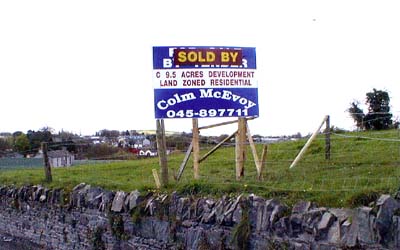 Everybody knows this is where the action's going to be. Look at the land that has been sold here in the last year for money that not so long ago would have seemed crazy to expect. Look at how easy it is to get here, given that the motorway is less than two minutes from my front door and I use it even to go to Naas because it is an easier and safer drive than going the direct old road. What must Dublin people think, coming from a city where houses are four to six times more expensive than the equivalents in Little Rock, capital of Bill Clinton’s Arkansas, and where it can take longer to get to Stillorgan from the city centre at peak time than all the way down to Kilcullen?
Everybody knows this is where the action's going to be. Look at the land that has been sold here in the last year for money that not so long ago would have seemed crazy to expect. Look at how easy it is to get here, given that the motorway is less than two minutes from my front door and I use it even to go to Naas because it is an easier and safer drive than going the direct old road. What must Dublin people think, coming from a city where houses are four to six times more expensive than the equivalents in Little Rock, capital of Bill Clinton’s Arkansas, and where it can take longer to get to Stillorgan from the city centre at peak time than all the way down to Kilcullen?
We’re going to explode.
And so, given that it is inevitable, we should look at what has happened to our county town in recent years.
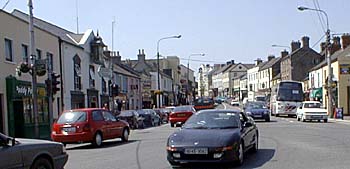 Naas (right) has grown dramatically under the 1996 Development Plan. But infrastructures didn’t keep pace. When the Bypass was opened, there were 30,000 traffic movements a day ... today there are upwards of 24,000 and it is expected that there will be 35,000 in a few short years. You can’t park in Naas easily any more, let alone drive through it in comfort. And this is going to get worse. Trust me. When I’m with people who have business in Naas, I drop them where they need to go, then head for an ‘outburb’ street where I can park and await a mobile call to come in and pick them up.
Naas (right) has grown dramatically under the 1996 Development Plan. But infrastructures didn’t keep pace. When the Bypass was opened, there were 30,000 traffic movements a day ... today there are upwards of 24,000 and it is expected that there will be 35,000 in a few short years. You can’t park in Naas easily any more, let alone drive through it in comfort. And this is going to get worse. Trust me. When I’m with people who have business in Naas, I drop them where they need to go, then head for an ‘outburb’ street where I can park and await a mobile call to come in and pick them up.
You almost can’t get your child’s name down for a secondary school in Naas unless you’ve been to the same school and your first children went there too (this may be an apocryphal exaggeration, but it’s not far from the truth).
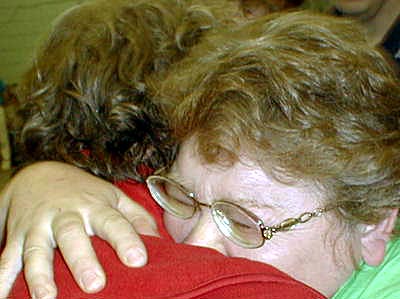 The most recent Development Plan for Naas, which rezoned more land for residential and commercial development, was pushed through by councillors who went against not just the advice of their professional planners, but also against the wishes of the majority of their electorate, as was proved by the fact that the first three candidates home in the recent elections were anti-plan aspirants like Mary Glennon (right).
The most recent Development Plan for Naas, which rezoned more land for residential and commercial development, was pushed through by councillors who went against not just the advice of their professional planners, but also against the wishes of the majority of their electorate, as was proved by the fact that the first three candidates home in the recent elections were anti-plan aspirants like Mary Glennon (right).
It is unlikely that Kilcullen's growth will stop at a mere doubling of the population. Given human nature and the undoubted attractions we have here at the moment, not least dual-carriageway access all the way from Dublin, there's going to be pressure to allow even further expansion of development ... it is not inconceivable that the Naas-Newbridge-Kilcullen Triangle may eventually be an equilateral one. Land recently sold in Kilcullen will on its own bring in around 800 people. Other land already programmed for development will bring in far more than that. And it doesn’t stop there ... already there are owners of prime land around Kilcullen clearing their way in planning terms to allow themselves gain a bonanza.
More power to them. They all deserve what profit they can make.
Just remember, the Kilcullen you know is in a terminal state. Irreversibly.
Remember it before it’s truly gone. Remember it with nostalgia, and love, even. And let’s have a bloody good wake. Before we get down to the serious business of raising properly a completely new Kilcullen.
(But I wonder where all these people are going to swim ...?)
Brian Byrne is a native of Kilcullen and still lives there. He is a journalist, author and broadcaster, and one of the proprietors of KNN - KildareNet News. This article is ©1999 Telling Tales Ltd.